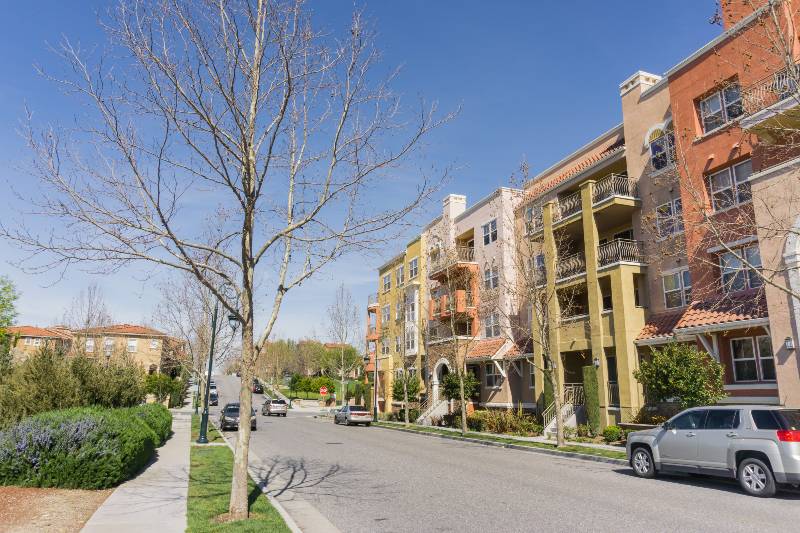Are you looking to build a successful multifamily portfolio? Building and maintaining a profitable investment portfolio requires dedication, knowledge, and experience. With the right strategy in place, you can start growing your wealth with real estate investment opportunities like multifamily housing. In this blog post, we’ll provide advice on how to get started building a strong multifamily portfolio that will help grow your passive income for years to come. You’ll learn about understanding the basics, steps to build a portfolio, case studies of successful investments, understanding the risks involved, and more – so let’s dive into what it takes to establish a robust rental property business!
Multifamily residential, also known as a multi-dwelling unit (MDU), is a housing classification where multiple residences are contained within a single building or complex. Some examples of these units are apartments and condominiums.
Key Takeaways
- Building a multifamily portfolio is not a solo endeavor. Assemble a robust team of professionals, including a real estate broker, These experts will provide critical advice, assist with property identification and acquisition, help with legal and tax structures, manage your properties, and provide necessary financing and construction services.
- Investing in multifamily real estate involves inherent risks including market risk, financial risk, operational risk, liquidity risk, and location risk. Successful investors understand these risks and mitigate them through diversification, conservative financing, thorough due diligence, proactive property management, and an exit strategy.
- Accelerate your portfolio’s growth by leveraging the equity in your existing properties and utilizing tax-efficient strategies. A value-add strategy can increase the value of your properties, while the 1031 exchange can defer capital gains taxes, allowing you to reinvest more capital into new properties. Always consult with a tax advisor or real estate attorney to ensure you’re maximizing these strategies effectively.
Table of Contents

Understanding the Basics
Multifamily real estate investing is a popular option for seasoned and new investors alike due to its unique advantages, such as high cash flow, economies of scale, and resilience during economic downturns. This guide will break down the fundamental concepts and strategies needed to build a multifamily portfolio.
Understanding the Basics
1. What is Multifamily Real Estate?
Multifamily real estate refers to properties designed to house multiple separate families in distinct units. These units could be in one building (like an apartment building) or spread out over multiple buildings within a single complex.
2. Multifamily vs. Single-Family Investments
While both single-family and multifamily properties can provide rental income, there are significant differences between these investment types.
Scale: Multifamily properties offer scale as an advantage, allowing for simultaneous income from numerous units under a single roof. On the contrary, single-family properties can only generate a single income stream per property.
Cash Flow: Investing in multifamily properties can be a smart financial decision, as they typically generate a higher cash flow than single-family homes. With multiple rental units, there are various income streams that can contribute to overall profits.
However, it’s important to recognize that cash flow in multifamily properties can also be more variable compared to single-family homes.
Vacancies can occur at any time, causing an imbalance in cash flow and putting pressure on property owners to quickly find new renters. That’s why it’s important to have a solid understanding of the multifamily real estate market and a plan in place to handle any potential fluctuations in income.
Risk Diversification: One of the key advantages of investing in multifamily properties is the lowered risk, due to the distribution of that risk across multiple tenants. In a single-family rental, losing a tenant means your income is immediately reduced to zero until you can fill the vacancy. However, with multifamily properties, should a tenant decide to move out of one unit, the income from the other units in the property can still keep coming in. This can provide a much steadier stream of income compared to single-family rentals, where losing a tenant can cause a significant financial setback.
Management: Multifamily properties require more complex property management, including managing multiple tenants and potential onsite amenities. However, the scale of these properties often justifies hiring professional property management, which can ease this burden.
Key Real Estate Investment Metrics
It’s essential to understand several key metrics when considering multifamily real estate investments: cap rate, occupancy rate, and cash flow.
1. Capitalization Rate (Cap Rate)
The cap rate is an important metric that real estate investors use to evaluate an investment property’s profitability. Calculated as the ratio of net operating income (NOI) to market value, a higher cap rate indicates a higher potential return on investment (ROI). It’s worth noting that cap rates can vary depending on the type of property and location—what’s considered a good cap rate for one property might not be the case for another.
So, savvy investors should consider a range of factors before making any decisions. Remember, cap rates are just one tool in the investor’s arsenal of measures for evaluating the potential profitability of real estate investments.
Capitalization rates or cap rates serve as a useful metric to compare a variety of prospective investment properties. In essence, cap rates represent the return on an investment property based on the net income it is expected to generate. Properties with higher cap rates are considered more attractive, as they have the potential to yield higher returns. However, it’s important to note that higher cap rates often come with increased risk as well. Investors must therefore weigh the risks against the potential rewards before making a decision.
2. Occupancy Rate
The occupancy rate refers to the proportion of occupied rental units out of the total units in a property. To calculate it, simply divide the number of rented units by the total number of units. For instance, if a 10-unit apartment complex has 9 rented units, its occupancy rate is 90%.
It’s worth noting that the occupancy rate is an important metric to pay attention to, as it impacts your rental income directly. A high occupancy rate can lead to increased cash flow and more stable investment, whereas a low occupancy rate can leave you with empty units and a loss in rental income. So, keep track of your occupancy rate closely to ensure a profitable investment.
3. Cash Flow
Cash flow is the net amount of money moving in and out of your investment. Positive cash flow means that the rental income exceeds the expenses (mortgage, maintenance, management fees, etc.), and negative cash flow means the expenses are greater than the income.
For example, if you earn $10,000 per month in rental income and have $8,000 in expenses, your monthly cash flow is $2,000. Aim for positive cash flow to ensure your investment is profitable.
Building Your Multifamily Portfolio
Building a multifamily portfolio involves several steps, from sourcing properties and arranging financing to managing the properties effectively.
- Market Analysis: Research potential markets carefully. Look for areas with strong job growth, a stable or growing population, and a healthy local economy. Analyze the local rental market to understand vacancy rates, average rents, and tenant demand.
- Property Sourcing: Once you’ve identified potential markets, start sourcing properties. Use online platforms, real estate brokers, and your personal network to
Steps to Build a Multifamily Portfolio
Embarking on the journey of building a multifamily portfolio demands a detailed understanding of the real estate market, financial acumen, and a high degree of patience and resilience. Below are the key steps you should take to create a multifamily real estate portfolio that is both profitable and sustainable.
1. Building Your Team
The first and perhaps the most critical step in building a multifamily portfolio is assembling a robust team of professionals who will contribute their respective expertise to your venture. Real estate investing, especially at the multifamily level, isn’t a solo operation. You’ll need to surround yourself with seasoned professionals who can help you navigate the various stages of the process.
Let’s illustrate this with a hypothetical team:
- Real Estate Broker: Jane is a real estate broker who specializes in multifamily properties. She understands the local market, has an extensive network of connections, and has a track record of success in finding lucrative investment opportunities. She will play a crucial role in identifying properties that align with your investment goals.
- Real Estate Attorney: Bob, a skilled real estate attorney, will ensure that your transactions are legally sound. He’ll be there to help you understand contracts, negotiate terms, and address any legal issues that might arise.
- Accountant: Sarah is a CPA who has a deep understanding of real estate taxation. She will help you structure your deals in a tax-efficient manner and maintain your financial records.
- Property Manager: Alex is a professional property manager experienced in managing multifamily properties. He will handle tenant relations, oversee maintenance, and ensure your properties operate smoothly.
- Lenders: Your relationship with lenders, such as Mike, a local community bank loan officer, will be essential for securing the necessary capital to finance your deals.
- Contractors: Reliable contractors like Tim’s Construction will handle property repairs and renovations, ensuring your properties maintain value and appeal to potential tenants.
2. Understanding Market Analysis
Effective market analysis is key to making informed decisions about where to invest. This involves a thorough assessment of various economic, demographic, and geographical factors. For example, let’s consider you’re analyzing the city of Springfield.
You’d start by examining Springfield’s economic trends: Are local businesses hiring? What’s the unemployment rate? Are there significant infrastructure developments planned for the next five years? You’d then look at the population demographics: What’s the median age? What industries do most residents work in? Is the population growing, stagnant, or shrinking?
You’d also assess the supply and demand dynamics of the rental market: How many multifamily properties are there relative to the demand? Are rents rising, stable, or falling? Finally, you’d study the local neighborhoods: What amenities are available? How are the schools rated? What’s the crime rate? This information will help you determine whether Springfield represents a potentially profitable market for multifamily investment.
3. Choosing the Right Property Type
Choosing the right property type involves a careful assessment of your financial goals, risk tolerance, and management capacity. For instance, if you’re aiming for stable, long-term returns and have substantial capital, you might consider Class A properties. These are often newer, luxury properties in prime locations.
On the other hand, if you’re seeking a balance of growth and cash flow, and willing to put some effort into improvements, Class B properties could be an optimal choice. These properties are generally older and may be located in less desirable areas, but offer significant potential for appreciation through renovations and management improvements.
Suppose you are more risk-tolerant and looking for higher potential returns. In that case, you might invest in Class C properties. These are typically older buildings in lower-income neighborhoods and may require significant capital for improvements, but they also present opportunities for substantial value add and higher cash flow.
4. Financing Your Multifamily Properties
Financing is a critical aspect of multifamily real estate investing. You have a variety of options, depending on the size of the property and your financial situation. For instance, you could secure a conventional mortgage for smaller properties. If you’re investing in a property with five or more units, you might have to opt for a commercial loan.
For example, you might approach a local community bank for a commercial loan to purchase a 10-unit apartment building. Alternatively, for a smaller, four-unit property, you might consider residential financing options, like an FHA loan, which offers lower down payments. It’s crucial to build strong relationships with various lenders to ensure you have access to the best financing options available.
5. Property Acquisition Process
The property acquisition process begins with a diligent search for potential investments. This could involve working with your broker, searching online real estate platforms, or even directly approaching property owners.
For example, your broker, Jane, might find a promising 12-unit property on the market. You would then conduct a comprehensive analysis, including a physical inspection, a review of financial statements, and an assessment of the property’s potential for appreciation or cash flow.
Negotiating and purchasing the property involve detailed discussions with the seller. Once the terms are agreed upon, you’ll secure your financing and move to close the deal. The closing process includes signing legal documents, making your down payment, and settling any closing costs.
6. Property Management Considerations
Effective property management is crucial to maintaining the value of your investment and ensuring steady cash flow. This involves dealing with tenants, overseeing maintenance, and handling the property’s financial aspects.
For instance, your property manager, Alex, would handle the process of finding and screening tenants, ensuring rents are collected on time, dealing with any tenant issues or complaints, and arranging for regular property maintenance and repairs. He would also prepare regular financial reports to help you keep track of your investment’s performance.
Building a multifamily portfolio is an intricate process involving many moving parts. By taking the time to build a competent team, conducting detailed market analysis, choosing the right property types, securing financing, navigating the property acquisition process, and managing your properties effectively, you can create a robust multifamily portfolio that stands the test of time.
Risk Management
Investing in multifamily properties, like any form of investment, involves some level of risk. The key to successful investing lies in your ability to accurately identify these risks and devise strategies to mitigate them effectively.
Understanding the Risks Involved
Investing in multifamily real estate comes with various risks, each of which needs to be understood and carefully managed:
- Market Risk: The real estate market is cyclical and subject to economic fluctuations. For instance, during an economic downturn, unemployment rates might rise, potentially leading to lower occupancy rates, declining rental incomes, and property devaluation. In a booming economy, increased demand could inflate property prices, making it more challenging to find lucrative investments.
- Financial Risk: This relates to the risk associated with the financial structure of your investment. High levels of debt can lead to significant financial risk, especially if rental income declines or interest rates rise.
- Operational Risk: This pertains to the daily operation of your properties. Operational issues can include everything from sudden maintenance problems and regulatory changes to difficulties in dealing with tenants or property managers.
- Liquidity Risk: Real estate, in general, is not a very liquid investment. This means that it can take a significant amount of time to sell a property at a fair price.
- Location Risk: The profitability of your property is tied to its location. Changes in the neighborhood or the broader local area can impact property values and tenant demand. For example, the closure of a major employer in the area could lead to a decrease in demand for housing, affecting your rental income and property value.
Strategies for Mitigating Risks
Effectively managing these risks involves a combination of thorough research, strategic planning, and proactive management.
- Diversification: One of the most effective ways to mitigate risk is by diversifying your portfolio. By investing in properties in different markets, you can insulate your portfolio against economic downturns in any one market. For example, if you already own several properties in City A, consider investing in City B to spread your risk.
- Conservative Financing: Maintain a conservative approach to financing. This could mean making a larger down payment, securing a lower interest rate, or choosing a longer-term fixed-rate mortgage. For instance, instead of leveraging an 80% loan-to-value (LTV) ratio, you might opt for a 70% LTV to reduce your debt service and increase cash flow.
- Thorough Due Diligence: Conduct thorough due diligence before purchasing any property. This involves analyzing the property’s financials, physically inspecting the property, and understanding the local rental market. By doing so, you’ll have a clearer picture of the property’s potential risks and returns.
- Proactive Property Management: Effective property management can mitigate many operational risks. This involves regular maintenance to prevent costly repairs, careful tenant screening to reduce tenant-related issues, and staying updated with local regulations to ensure compliance.
- Exit Strategy: Always have an exit strategy. Whether it’s selling the property after a certain period, refinancing to pull out equity, or converting the property to a different use, an exit strategy gives you options if things don’t go as planned.
Risk is an inherent part of any real estate investment. However, with careful planning, thorough due diligence, and proactive management, you can mitigate these risks and increase the likelihood of a successful and profitable investment.
Scaling Your Portfolio
Growing a multifamily portfolio involves a combination of strategic acquisitions, efficient capital management, and effective use of tax-efficient strategies. Below are some tips and strategies for portfolio growth.
1. Strategic Property Acquisition
Acquiring additional properties is the most direct way to grow your portfolio. It involves identifying promising investment opportunities based on your investment goals, market analysis, and risk tolerance. For example, you might choose to acquire properties in emerging markets with high growth potential, or you might focus on undervalued properties in established markets where you can add value and increase rents. The key is to be selective and base your acquisition decisions on thorough due diligence and analysis.
2. Value-Add Strategy
A value-add strategy involves acquiring properties that present opportunities for increasing value through improvements, operational efficiencies, or rent increases. This could involve investing in properties that need renovations, have below-market rents, or suffer from poor management. For example, you might purchase a Class B property with outdated amenities and increase its value by making modern upgrades, thereby attracting higher-paying tenants and increasing rental income.
3. Portfolio Diversification
Diversifying your portfolio across different markets can help mitigate risk and create more opportunities for growth. By investing in different geographic locations and property types, you can balance the risks and rewards of your investments and take advantage of different market dynamics. For instance, you might diversify your portfolio by investing in a mix of urban and suburban properties, or by investing in different regions or states.
Leveraging Equity for Growth
One effective strategy for portfolio growth is to leverage the equity in your existing properties. As you pay down your mortgages and your properties appreciate in value, you build equity that can be used to finance additional property purchases.
For instance, suppose you purchased a property for $1 million with a $200,000 down payment. After several years, you’ve paid down $100,000 of your mortgage and the property has appreciated to $1.2 million. You now have $300,000 in equity ($200,000 initial down payment + $100,000 mortgage paydown + $200,000 appreciation).
You could then take out a home equity loan or line of credit, or refinance the property to tap into this equity. Suppose you’re able to access 70% of your equity, or $210,000. This could be used as a down payment on another property, thereby expanding your portfolio without needing to come up with additional cash.
Understanding 1031 Exchange
The 1031 exchange, named after Section 1031 of the Internal Revenue Code, is a powerful tool for portfolio growth and wealth preservation. This provision allows investors to defer capital gains taxes when they sell a property and reinvest the proceeds in “like-kind” property. By deferring taxes, investors can keep more of their money working for them, accelerating portfolio growth.
Let’s say you sell a property for $1 million that you originally purchased for $600,000. Normally, you’d have to pay capital gains taxes on the $400,000 profit. But by using a 1031 exchange, you can reinvest the entire $400,000 into a new property, deferring the taxes and allowing you to invest in a larger or more profitable property.
To fully understand the rules and complexities of the 1031 exchange, it’s crucial to consult with a tax advisor or real estate attorney. Keep in mind that the rules for a 1031 exchange are very specific and must be strictly followed to qualify for tax deferral.
I’ve written a detailed article specifically about 1031 exchanges, which goes in-depth into the process, rules, and strategies for maximizing its benefits. If you’re interested in exploring this powerful tool further, I highly recommend you visit and read the article [insert link here] for a comprehensive understanding of the 1031 exchange.
To summarize, expanding your multifamily portfolio requires using various methods such as acquiring new properties, managing finances, and implementing tax-efficient strategies. With these tools, you can boost the growth and profitability of your portfolio over the long run.

How to Build a Multifamily Portfolio FAQs
Q: What is multifamily investment?
A: Multifamily investment refers to the acquisition and ownership of properties that contain multiple units, such as apartments or duplexes. It involves renting out these units to tenants and generating income from the rental payments.
Q: Why should I consider a multifamily investment as an investor?
A: Multifamily investments offer several advantages for investors. They provide a steady stream of rental income, allow for better diversification of your real estate portfolio, and offer potential for long-term wealth creation through property appreciation.
Q: How do I finance a multifamily investment?
A: Financing options for multifamily investments include conventional mortgages, government-backed loans, private lenders, and partnerships. It is crucial to evaluate the financing options based on your investment strategy and financial goals.
Q: What is a value-add strategy in multifamily investing?
A: A value-add strategy involves purchasing a property that needs improvements or renovations to increase its value and rental income. By implementing effective renovations and property management strategies, investors can enhance the profitability of their multifamily investments.
Q: How important is the management team in a multifamily investment?
A: The management team plays a critical role in the success of a multifamily investment. They are responsible for property upkeep, tenant management, lease negotiations, rent collection, and overall financial performance of the investment.
Q: What are key metrics to consider when evaluating a multifamily investment?
A: Key metrics to consider include the purchase price, rental income potential, vacancy rates, operating expenses, market trends, projected cash flow, capitalization rate, and return on investment. These metrics help assess the profitability and viability of the multifamily investment.
Q: How can I build a profitable multifamily investment portfolio?
A: Building a profitable multifamily investment portfolio involves thorough research, analysis, and due diligence. It also requires diversification of your property portfolio, strategic property acquisitions, effective management, and continuous monitoring of market conditions.
Q: Are multifamily investments better than single-family investments?
A: The choice between multifamily and single-family investments depends on your investment goals, risk tolerance, and preferences. Multifamily investments generally provide higher income potential and scalability compared to single-family properties.
Q: How do I deal with deferred maintenance in a multifamily investment?
A: Dealing with deferred maintenance in multifamily investments involves conducting thorough property inspections, prioritizing repairs and maintenance, budgeting for necessary renovations, and implementing proactive property management practices to prevent future issues.
Q: What are some common challenges in managing multifamily properties?
A: Some common challenges in managing multifamily properties include tenant turnover, rent collection, property maintenance, dealing with tenant complaints, handling lease agreements, ensuring compliance with local regulations, and maintaining positive tenant relations.
Conclusion
Overall, by building a multifamily portfolio, investors can diversify their income and create additional streams of passive income. The key is assembling the right team of real estate professionals to help you with essential advice, identification, acquisition, management, and financing of your properties. If you are looking to start or make the most of your multifamily portfolio, call or schedule a free consultation with me so I can answer any questions or provide assistance in getting started toward reaching your financial goals.
I may even be able to spot potential trouble spots that could prevent investors from realizing their desired return on their investment. Remember, if you take all the right steps along the way your multifamily portfolio could generate substantial returns over time. Don’t delay investing in a multifamily portfolio – it’s a solid way to build wealth and potentially set yourself up for long-term success!




